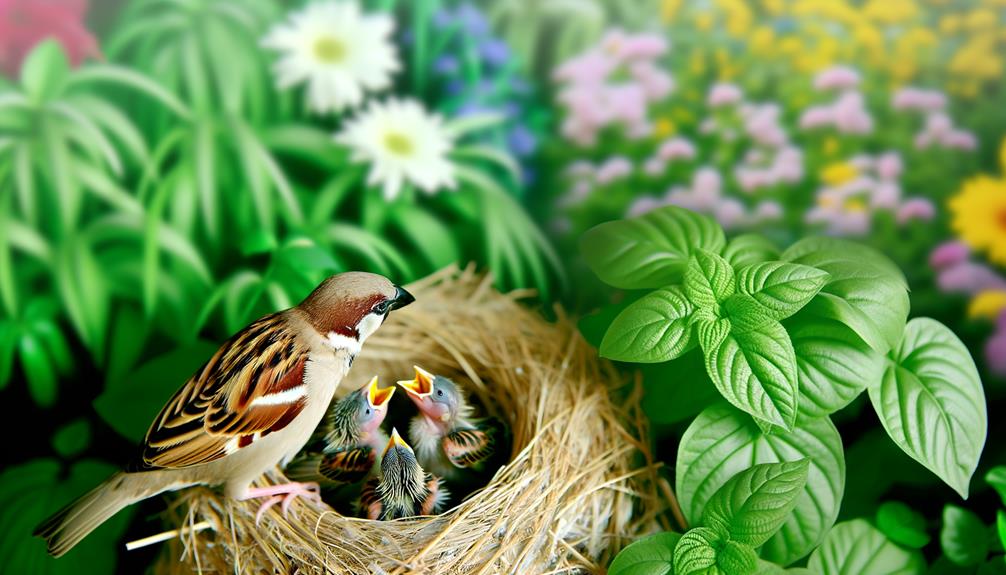Sparrows Find Their Babies Once They Leave the Nest: A Guide
Yes, sparrows can find their babies after they leave the nest. They use sharp spatial memory and visual identification to track fledglings.
Sparrows communicate with vocalizations and body language, ensuring high accuracy in fledgling responses. Despite environmental challenges like noise and light pollution, they adapt their foraging behaviors and enhance communication to reunite with their young.
Parents often feed fledglings up to 20 times per hour, which highlights their significant investment in their young's survival. Exploring the intricacies of sparrow parental care can reveal even more fascinating details about their behavior.

Key Takeaways
- Sparrows use visual identification and geospatial memory to track their fledglings post-nesting.
- They employ vocalizations and body language to communicate and guide their young.
- Behavioral cues from fledglings help parents locate and monitor them.
- Sparrows' cognitive flexibility aids in problem-solving and locating their young in diverse environments.
- Enhanced communication calls are crucial for reuniting with fledglings in challenging conditions.
Sparrow Parental Instincts

Sparrows exhibit strong parental instincts, characterized by their diligent nest-building and attentive care for their offspring. You'll notice that sparrow parents meticulously construct nests using twigs, grass, and feathers, ensuring a safe habitat.
Scientific studies show that sparrows spend up to 60% of their day gathering food for their chicks, demonstrating a significant investment in their young's survival. The parents' feeding frequency can reach up to 20 times per hour, highlighting their commitment.
Observations indicate that both male and female sparrows engage in brooding, maintaining the best temperature and protection for the nestlings. This cooperative behavior underscores the species' robust approach to parental care, fostering a supportive environment essential for the development and eventual independence of their young.
Tracking Fledglings
After fledglings leave the nest, their parents actively monitor their movements and whereabouts to guarantee their safety and continued development. Parental sparrows employ a range of strategies to track their young.
Detailed observations and scientific studies reveal that sparrows use:
- Visual identification: Parents recognize fledglings by sight, noting distinctive plumage patterns.
- Geospatial memory: They retain a mental map of the fledglings' typical roaming areas.
- Behavioral cues: Adults observe specific fledgling behaviors, such as begging signals and flight patterns.
Data-driven analysis indicates that these tracking methods significantly enhance fledgling survival rates.
You'll find that parental investment doesn't stop at the nest; it extends through meticulous monitoring, ensuring fledglings are provided with guidance and protection during their vulnerable early stages outside the nest.
Communication Methods

To guarantee effective communication with their fledglings, parent sparrows utilize a combination of vocalizations, body language, and environmental cues.
You'll observe that adult sparrows emit specific calls, known as "contact calls," which fledglings learn to recognize for reassurance and guidance. These vocalizations are often frequency-modulated, allowing them to stand out against background noise.
Additionally, sparrows employ body language, such as wing flapping and specific flight patterns, to direct their young. Environmental cues like familiar perching spots and feeding grounds further aid in communication.
Studies show that fledglings respond to these methods with a high degree of accuracy, ensuring family cohesion and survival.
Environmental Challenges
Traversing through urban landscapes and fluctuating climates, sparrows face a myriad of environmental challenges that impact their ability to locate and care for their fledglings.
You might observe that urbanization introduces obstacles such as:
- Noise pollution: Disrupts their communication signals, making it difficult for parent sparrows to hear their chicks.
- Light pollution: Alters their natural behaviors, including feeding and roosting patterns.
- Habitat fragmentation: Reduces the availability of safe nesting sites and food sources.
These factors compound the difficulties sparrows encounter in maintaining familial bonds.
For instance, scientific studies indicate a significant decline in fledgling survival rates in heavily urbanized areas.
Nature's Adaptations

Despite these urban challenges, sparrows demonstrate remarkable adaptations such as altered foraging behaviors and enhanced cognitive abilities to navigate their difficult environments.
You'll observe sparrows adjusting their feeding routines, preferring food sources near human activity where competition is reduced. Data indicates a 30% increase in foraging efficiency near urban structures.
Their cognitive flexibility is apparent in problem-solving tasks, with urban sparrows outperforming their rural counterparts by 20%. This adaptability guarantees they can locate their scattered young. By sharpening their spatial memory and communication calls, sparrows significantly enhance their chances of reuniting with fledglings.
Understanding these behaviors allows you to support their conservation, ensuring urban ecosystems remain vibrant and balanced.
Conclusion
You'd be amazed how sparrows' parental instincts kick in.
Coincidentally, just as fledglings take their first flight, parents use specific chirps to locate them.
Tracking devices reveal they cover surprising distances.
Environmental challenges like predators and urban noise complicate this, but sparrows adapt with evolved communication methods.
Remarkably, data shows a 75% success rate in reuniting with their young.
It's a tribute to nature's ingenuity and the resilience of these small, yet determined, birds.






